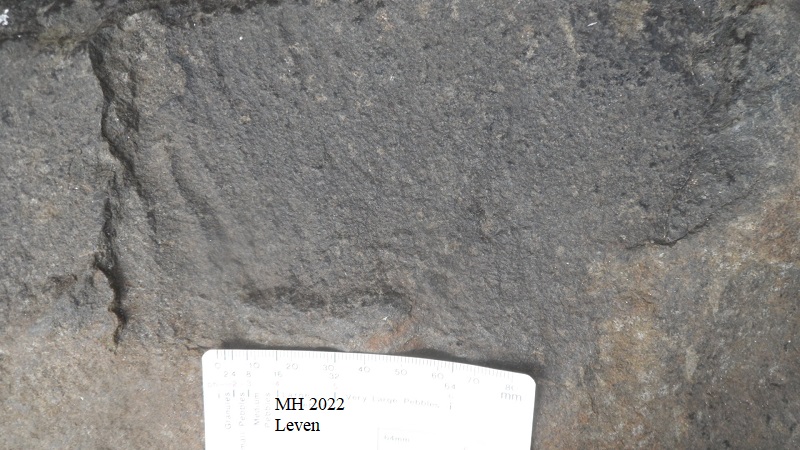
Welcome to the Ice Age Coast website
Whin Sill erratic at Leven
By Colin Howes and Mike Horne
During the Yorkshire Naturalists' Union
VC63 meeting to Leven on 25 June 2022, Colin Howes of the Doncaster Natural
History Society noticed a large brown, rectangular, domed, water-worn
boulder embedded in the grass verge of South Parade, adjacent to the
frontage of the fine brick built early 19th century Grade II
Listed Building named Westfield House (TA 103453). In this Hull valley
landscape with no exposed solid geology or underlying strata which could
have produced this rock type, this incongruous object, unless brought by
human agency, seemed likely to be an ‘Erratic’ brought by glacial action
during the Quaternary ice ages.

Visual inspection showed the boulder to be a medium grained basic igneous
rock and the most likely name would be ‘Whin Sill’, a dolerite from northern
England. To obtain a more accurate identification a geologist would need to
remove a sample to see an unweathered surface and make a thin section. Even
then it is not always possible to link the erratic to its original source.
Some erratics are readily identifiable and come from a single locality, such
as Shap Granite and Larvikite, for others the identification has to remain
more generic.

It is probably not in its original position and was probably moved there to
protect the corner of the house from vehicle damage. There are several large
quarries (some disused and some still active) in the area around Leven
extracting glacial and post-glacial deposits.
Whin Sill,
formerly referred to as Whinstone, has a specific geographical distribution
in the northern Pennines from Teesdale to Berwick in the Scottish borders
where it forms the basis of such celebrated landscape features as High
Force, High Cup Nick and Lindisfarne and is the elevated topographical
feature on which Hadrian’s Wall was built.
At the end of the Carboniferous and the beginning
of the Permian geological periods (about 301-294 million years ago),
tectonic plate movements (the Variscan orogeny) created four surges (swarms)
of volcanic activity intruding magma between existing rock strata and
erupting at surface via fissures. On cooling it solidified into the tough
crystalline doloritic rock referred to as Whin Sill. Since quite large
boulders of Whin Sill feature in the glacial boulder clays of Holderness and
east Yorkshire, examples in North Cave (SE8932) and Cottingham (TA0432)
being used as curb stones (Anon, 1894), it is likely its occurrence in Leven
is similarly via glacial progression from the north.
Recording, mapping and identifying glacial erratics became popular with the Yorkshire Naturalists’ Union and its affiliated societies in the late 19th century, the YNU forming The Yorkshire Boulder Committee to organise this work which reported in the YNU Transactions and The Naturalist from 1894 to 1905. Also The East Yorkshire Boulder Committee of the Hull Geological Society reported in their Transactions from 1893 to 1909 and Humberside Geologist 1987 to 2021. By this means it has been possible to trace the origins and routes of glaciers across Ice Age Yorkshire.
In Hornsea a similar but larger boulder of Whin
Sill, first recognised by W.H. Crofts (Anon, 1896) who described it as
dolerite, achieved celebrity in 2009 when its scientific and cultural
significance was established by the Hull Geological Society and local
community action. Now referred to as the
Hornsea Tesco Boulder,
it
was repositioned through the generosity of the nearby TESCO store in a
landscaped plot of its own, accompanied by a stainless steel information
panel and unveiled to the public with civic/corporate pomp in 2012 (Haughey
et al, 2020).
Until now, the
presence of the Leven boulder seems to have evaded academic notice, though
whether it has generated any local folklore is yet to be discovered. During
the YNU excursion, having seen examples of Leven’s landscape features and
historic and vernacular architecture, the boulder at over 290 million years
of age, is likely to be by far the oldest object in the locality.
References
Anon. 1894 Report of the East
Riding
Anon. 1896 Report of the East
Riding
Haughey D, M Horne and S Jones 2020.
The Hornsea Tesco Boulder.
(c) Hull Geological Society 2023